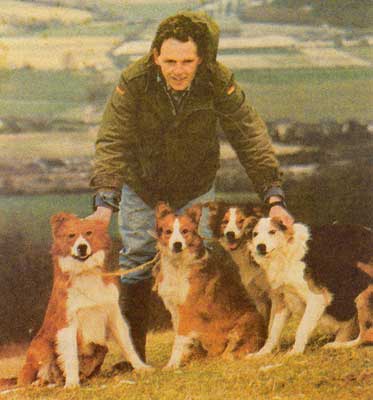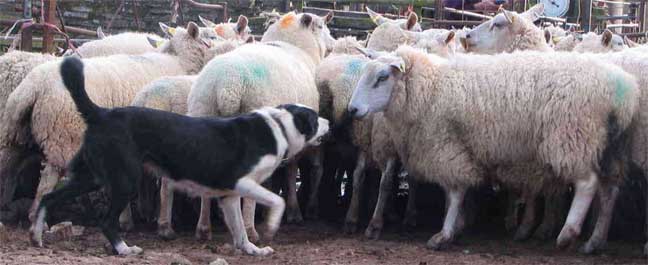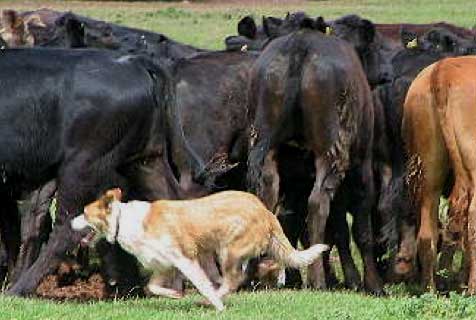

![]()
BORDER COLLIE COUSINS
THE WELSH SHEEP DOG
Above, Adeline Jones' Welsh Sheep Dog, Heini
THE WELSH SHEEP DOG TODAY
Written into the Ancient Welsh Laws codified by Hywel Dda ca. 920 AD, is the herdsman's cur, regarded as, with a "bothy" and a knife, one of the three necessities for a herdsman's summer shieling.
At one time, Wales had many different types of shepherds' dogs. Much of Wales, because of its mountainous terrain, remained isolated and remote well into the 20th century, and Barbara Carpenter, in an article she wrote in 1994, was able to describe a few scattered remnants of these types that she remembered seeing in the 1970s and '80s.
 Left, John Davies of Dyfed with three of his Welsh Sheep Dogs
Left, John Davies of Dyfed with three of his Welsh Sheep Dogs
This is how matters stood in 1997 when John Davies, from the northern Welsh county of Dyfed, called a meeting in January of that year of people interested in forming a Welsh Sheepdog Society or Cymdeithas Cwn Cymreig. Davies thought that the remnants of the lines of Welsh sheepdogs were worth conserving. Quoted in the Farmlife section of Farmers Weekly, March 1997, Davies said:
Our forefather were drovers and always kept [the lines] pure, but now we are having difficulty finding new bloodlines [to work our sheep and Welsh black cattle]...My great grandfather ...helped the drovers take stock from Tregaron to Brecon, from where they went on to London. The Welsh sheepdog is good with cattle as well as sheep, and in those days 700 cattle would be taken to London by just a few men and the dogs. One dog would run in front, leading and clearing the way with the other dogs driving from behind. The dogs would keep the stock together overnight and act as guards against robbers. They could be fierce, and when the drovers finished they were not safe to keep...
Thus, this old and venerable "working collie" from Wales, perhaps closer to its origins than our own breed, the Border Collie, is to its original stock, has a new lease on life.
The Welsh Sheep Dog is one of the most diverse registered herding breeds there is, as it is never bred for looks. Linda Rorem quotes John Holmes as saying, "There are several other types of Collie quite distinct from the Border Collie in that they are 'loose-eyed' workers." John Davies said, "Welsh sheepdogs work with their tails held high and bark to drive the sheep out." The Welsh Sheep Dog Society describes them as being of "most colours, including Black, Black and Tan, Black and White, Blue, Red or Roan," and that they are "naturally strong...have broad muzzles with ears usually folded forward. Their bodies are muscular and their energy and bravery limitless." They can be rough- or smooth-coated. In order to be registered, dogs must work satisfactorily in front of an inspection panel. Working ability is of major importance and trialling is not taken into consideration by the Society. Many different types are accepted, making it possible that the so-called extinct breeds of Welsh sheepdogs may in fact be preserved in the modern Welsh Sheep Dog.
According to some, Welsh Sheep Dogs have been bred continuously in Wales for more than 800 years. More stock is being sought out as far afield as Argentina, where the original bloodlines may have been shipped to Patagonia with the thousands of farmer who immigrated from Wales in the 19th century. In the United States, a few people have taken interest in the breed, some as possible breeding material for restoring that elusive "breed", the Old Time Farm Shepherd. According to Linda Rorem, "Dogs of this type were found all over Britain; taken to America by settlers, they became the basis for such American farm dogs as the English Shepherd and the Australian Shepherd."
[Please go to Herding on the Web: The Welsh Sheepdog for more information about this breed]
HOW DOES THE WELSH SHEEP DOG WORK
AND HOW IS IT DIFFERENT FROM THE BORDER COLLIE?
We saw above that the Welsh Sheep Dog was a loose-eyed worker. In September/October 2006 my husband and I travelled to Britain for vacation and to visit friends. While we were visiting Barbara Carpenter, we took her with us to see Adeline Jones, who, with her husband Tim, farms sheep and cattle in Hereford, near the Welsh Border, with the help of Welsh Sheep Dogs. We were curious as to how the Welsh Sheep Dog differed from the Border Collie in working style, for, as you can see, in looks they don't seem to vary much. Adeline kindly demonstrated with Milwyn Heini ("Heini"), a red (yes, they call this color red where we would call it tan) Welsh Sheep Dog and allowed us to photograph her working.
This is Adeline Jones with one of her Welsh Sheep Dog puppies. Welsh Sheep Dogs come in just about every color a Border Collie does, and have smooth or rough coats as well (though if the photos at the Welsh Sheepdog Society are indicative, smooth coats seem to be favored in the rough Welsh hill country).
Adeline sent Heini and her husband's dog, black-and-white Gorslas Pengyn ("Pen") to cut out and bring part of a flock to us.

Above, Tim Jones' Gorslas Pengyn on sheep. (Photo courtesy of Adeline Jones.)
If you are used to seeing Border Collies work, the way the Welsh Sheep Dogs work will be somewhat of a shock to you. They are "upright" or "loose-eyed" workers, meaning they do not crouch or eye the sheep. Heini works the sheep by "wearing" or moving back and forth behind the sheep. At times she looked almost disconnected (Adeline calls it "relaxed"), but, as you can see from the photos below, when the sheep face her, she faces them and is all business.
Something you can't see in these photos is that Welsh Sheep Dogs are what Barbara Carpenter calls "rough workers". Without "eye" to force the sheep and at the same time hold herself back from them, they sometimes must rely on teeth to press the point home if the sheep are stubborn. Heini, Adeline says: "doesn't grip at all as a rule, with sheep she is much more likely to put a bit of pressure on them and just wait for them to move, or bark, though if she is working something very stubborn like rams if I ask her she will nose them. With cattle she is different altogether, much harder. In theory, a WSD should use bark to move 'stuck' sheep, teeth only as a last resort."
WSDs, Adeline says, "use their tail as a balancing stick and also in signalling intention to their stock. Where a BC would use a low head, low tail and a lot of eye to move a sheep, a WSD would be standing erect with a high head and erect tail, in a gesture similar to what they use when signalling dominance to other dogs....our WSD here have [a] very rare whitehead gene (like what makes
a OES have a white head) and recessive black (very rare only really seen in
GSD and Shelties)."
In this photo (left), Heini has brought the sheep down to the driveway near the house. She is still herding them, but appears finished, as she does in the photo below when the sheep are returning to their pasture. Unlike a Border Collie, whose eyes are rarely taken off the sheep, loose-eyed dogs do not appear as intense or focused. It is difficult to tell, but she is aware of the sheep's every movement.

Above, Milwyn Heini on cows. (Photo courtesy of Adeline Jones, Wilden Farm.)
Copyright © 2013 by Carole L. Presberg
Thanks to Adeline Jones for supplying additional information for this article
Photographs by David L. Presberg unless otherwise noted.
Return to
![]()
BORDER COLLIE COUSINS
THE OTHER WEB PAGES WE MAINTAIN
These web pages are copyright ©2013
and maintained by webmeistress Carole Presberg
with technical help from webwizard David Presberg
ALL RIGHTS RESERVED
If you are interested in using ANY material on this website, you MUST first ask for permission.